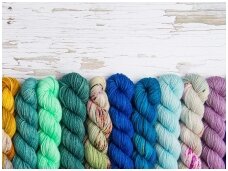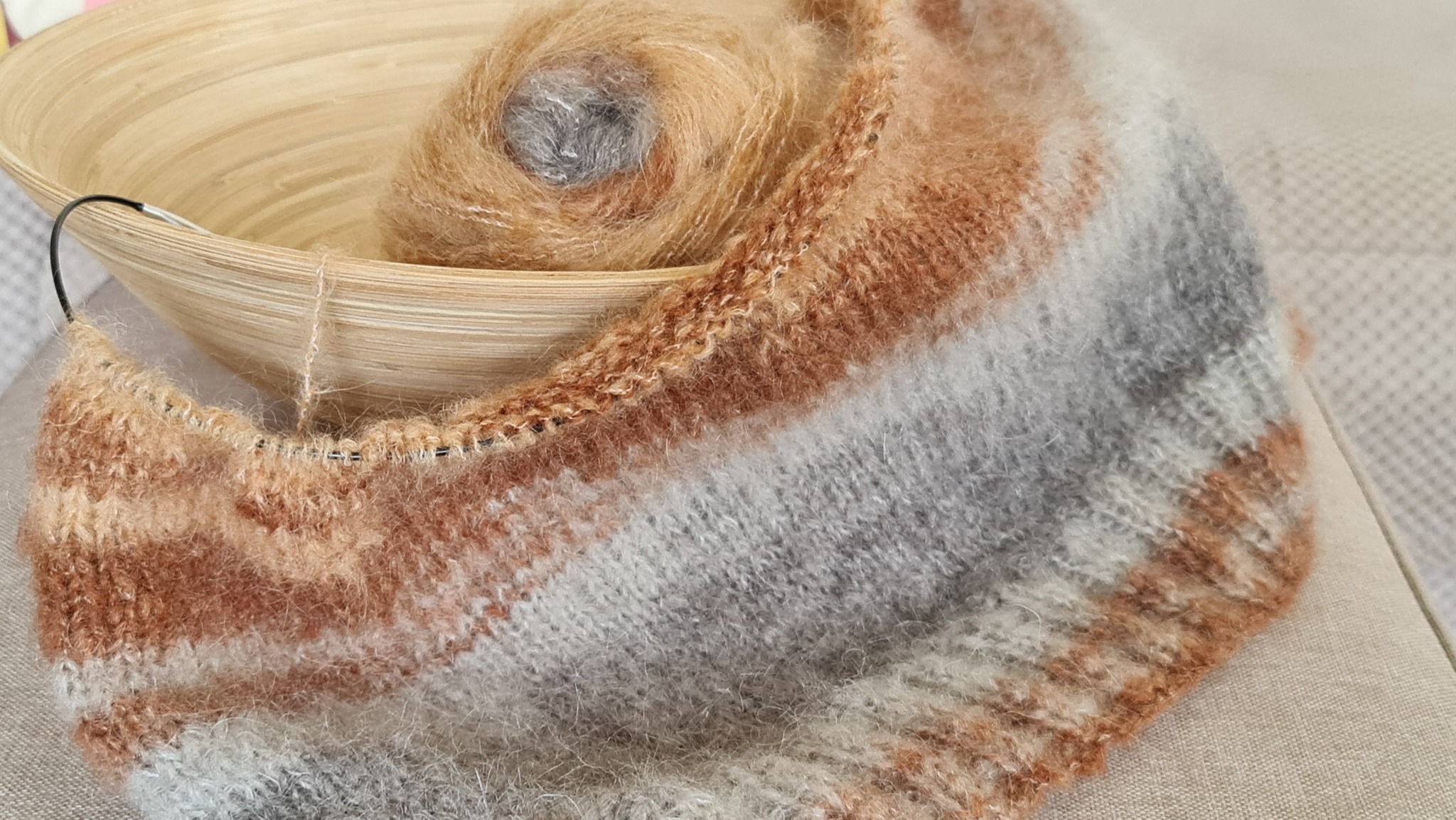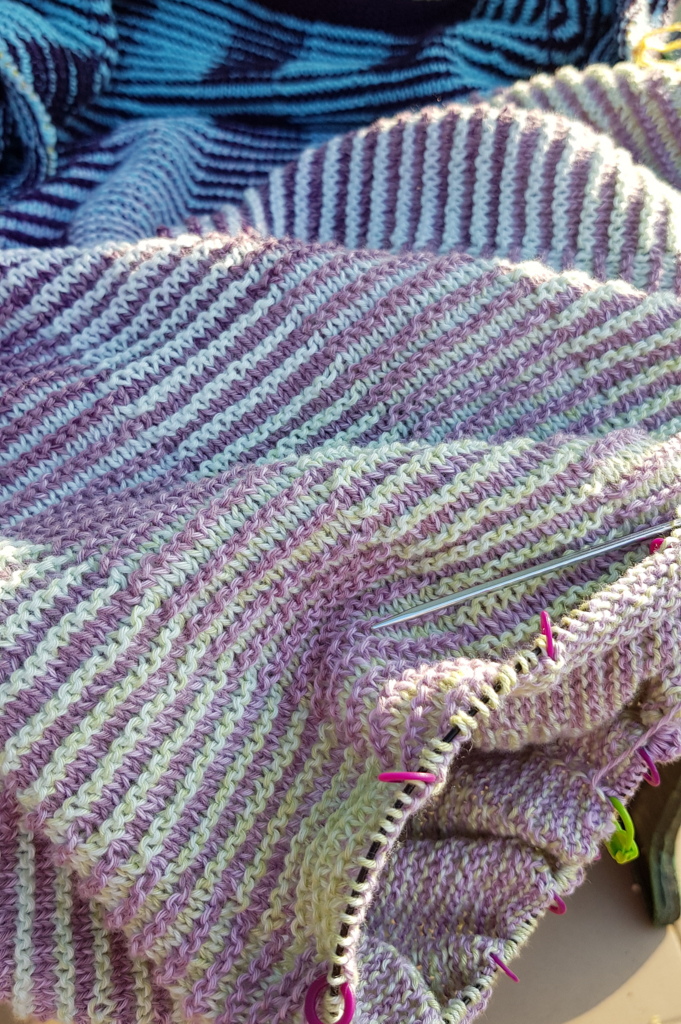Colours: how to choose the right one and not get lost
-

Every day, every step of the way, colours are our most loyal friends. They lift our spirits, calm us, inspire us, soothe us, influence us in one way or another, whether we like it or not, whether we notice it or dismiss it as a trivial detail. When we are sad, we hide under dark, inexpressive shades as if we want to be invisible. But when we are happy, uplifted, in love, the world shines in the most beautiful colours :)
Colours in yarn and yarn-related creativity in general are one of those titans that hold the whole needlework world on their shoulders. We always look at it very carefully, because it is the colour range, the dyeing, the pattern, the combination of shades, that is the moment that paves the easiest way for one or another yarn to appear on our shelves. It is always interesting for us to follow fashion trends as well as our customers. Often, the shelves of the biggest brands and the tones that dominate them blow similar winds into your knitting baskets. When we opened our e-shop, everyone wanted 'sea wave' (teal) tones. We probably could have filled half the shelves with just a ball of this colour and we would have been quite successful. Then came the mass craze for 'ash pink' or 'aged rose'. And there have been many such colour waves. With the advent of thread rolls on the market, the game of ready-made thread combinations began. The manufacturers created, we enjoyed.
Colors as a reflection of our everyday life
It is often possible to observe and see how the choice of one colour or another is determined by much more global issues. For example, as the pandemic drew to a close and everyone slowly became freer from it, everyone dropped the blue thread from their choices. This was quite an interesting joke, because blue and its variants are very much a favourite colour among us Lithuanians and almost always popular. On reflection, this could be explained by the fact that blue is the colour of peace, concentration, restraint, inner reflection and being with oneself. Throughout the quarantine, we have been so caught up with ourselves and so sincerely fed up with it that the blue thread has been quietly waiting for a good year for a rebirth. But at the same time, green blossomed! And it blossomed in such a way that sometimes it seemed there were no other colours around. Since green is always the colour of health, of life, of rebirth, of nature, of new beginnings, it also seemed logical enough. Another interesting point was that two years ago, when the war in Ukraine broke out, at least the customers of our shop were vehemently and absolutely refusing red yarn. Nobody needed red in any season on any occasion. Even before Christmas, when red combinations become popular for a while, red was almost unmovable. If you are still wondering why, let us remember the basic colour of the Soviet Union and all communist regimes. And the answer becomes obvious.
Colours are a mirror of our mood, our attitude, our approval or opposition, our inner state. In dark colours, if it is not related to practicality, people often tend to hide or simply be less visible. Almost always, teenagers go through a "black period" before their inner rebellion and self-seeking subsides. It is particularly interesting when the weather turns cold and winter sets in, and everything around them is already grey, and most people slip into dark coats and dark scarves. It is as if they want to hide from the coming winter and wake up when the first buds start to open. We think that men, too, often tend to go too far into the dark. Probably not out of ill will. It's more out of habit and Lithuanian restraint. But black and dark grey are not always the only and necessary colours. Even if you want to keep a calm, solid and practical look, black can be spiced up or replaced by dark blue, chocolate brown, forest green or ripe cherry/burgundy. And if you don't want to change the contents of your wardrobe or it just doesn't make as much sense, you can pick up a single brighter ("brighter" doesn't mean a combination of all the colours, let it just be COLOUR) scarf and instantly the masculine solidity is different ;)
"My" colour: how to choose the right one?
- A colour is for you. Choose the colour you want at the moment. And for you. Not someone else's. Not for a shop window, not for your husband, wife or children, not for your mum, your aunt, your colleague or your friend. Just you. Colour is always an expression of your inner state and your choice, so no other person is involved. We are talking here more about knitting, when you take the isoles of the colour you want and spend a lot of time with them until they turn into knitted fabric. This means that "your" colour and its energy is circulating around you for quite a long continuous period of time. However, this choice can also be applied to a festive ruby, or to any garment you buy in general, according to your wishes. Of course, asking a loved one's opinion is always an option, especially when you have several equivalent choices. But the final decision is yours. When you have colours with which you feel genuinely comfortable, there is self-confidence, self-belief, inner peace, and with it always comes a reduction in stress levels and a calmer, happier and even more beautiful you.
- Colours are not differentiated by age. It is not necessary to think that the more respectable the age, the fewer colours are appropriate for us. And there is no need to slip into dark browns or other similar colours as we get older. Dark colours age even more, while fresh, subtle but not boring colours rejuvenate. So if you're looking for a recipe for youth, fresh, colourful tones are sure to be one of its ingredients.
- The element of surprise. Experiment from time to time! Especially if you don't know what you want at the time. Surprise yourself and create a knitted piece in colours that are "not your own". This is very suitable for those colours that you would like to use, but which are left out because of various inner barriers and beliefs that limit us. Try. In our experience and that of others, it's definitely worth it :)
Colours and children

This is another separate topic, as it is often encountered in practice if you come with your little ones to choose a yarn. We are not talking about teenagers and older children here, because they usually have such strong opinions that no one tries to "break" them somehow. But with little customers, sometimes it's different. I have one situation that sticks in my mind very deeply, and it is always an example to me of how not to behave. Once, a really, really, really long time ago, a family with children came to see us. While everyone was busily fussing with the yarn, a small, very sweet little girl was standing quietly by the shelf of pink balls, quietly stroking the yarn. Suddenly her mother came up and told her very clearly to put them on the shelf, because she would not like the pink one. And the girl did. We are not going to talk here about lovelessness, indifference and things like that, because it was a really nice family. However, it is a very good example of how often we adults tend to decide for those who do not hesitate to listen to us. Therefore, in our opinion, if you knit for your children and let them choose the yarn for their knitting, let them choose to the end. A child is exactly the same person and he has exactly the same needs and likes the colours he needs. Even if you think otherwise at the time. All girls have to go through a pink period and all boys a blue period. That is the way it is. There was a time when I knitted only pink for my daughter and I was really looking forward to more colour in her choices. And they did. Now pink is a rare choice. So for those who are now "forced" to knit in pink, I can tell you that this phase passes very quickly... you won't notice how you'll start to miss that little girl in pink...
What if you like the colour but it doesn't "suits you"?
-
First of all, there are no wrong colours. There are only the wrong shades. For example, if you want yellow, but you think and see that it doesn't really suit
 your face, go for another shade. If you don't like amber yellow, lemon tones are almost guaranteed to look nice; if you don't like olive or pistachio green, try emerald or cooler greens. There are plenty of shades (even greys, they say there are about 50 :). You just have to find the right one for you.
your face, go for another shade. If you don't like amber yellow, lemon tones are almost guaranteed to look nice; if you don't like olive or pistachio green, try emerald or cooler greens. There are plenty of shades (even greys, they say there are about 50 :). You just have to find the right one for you.
- Another option is to mask that colour with others. For example, this whole autumn and winter I've been into natural, calm, earthy colours. When I see cocoa shades in clothes, on the street, in cars, in interiors, I melt from the maloum of how beautiful I am :) At this moment in my life, colour peace is very close to me. Among the shades that make me melt are warm and cosy notes of cinnamon. But no matter how close I put them to my face, I can see that they are not mine though. And then I found the perfect thread, when cinnamon brown was covered with grey tones. I knitted the sweater so that the grey was at the face and the cinnamon was somewhere in the middle. I got a cinnamon delight and a garment that was perfectly "in your face". As a rule of thumb, you don't always have to look for a colour combination in one ball. Choose a few colours and pattern or stripe, create the combination yourself and in a way that suits you, incorporating a colour you like, but which is not a perfect match, into the company of others.
The magic of creating in "YOUR" colours
I was thinking while writing this text. Over the lifetime of the shop, I have knitted many different kinds of knits. So which ones are THE ones? Which knits are the ones that are still in my wardrobe, still worn, still liked and still never get old, even after all these years? And after some thought, I realised that there are two: the Lola Pastello scarf and the Whirl shadow-patterned knitted dress. This scarf was crocheted in 2018 and it's with me every summer, whether as an evening accessory when it's cooler or for cuddling up on a terrace, balcony or by the sea. This is the kind of piece that will rip before I get sick of it. And the Whirl dress is a former chart-topper, which has a lot of work put into it and which has set records both here and in Holland (because it is knitted with yarn from a Dutch manufacturer). But that's not the point. On closer inspection, the two knits are very similar in colour scheme. I chose the colours for these knits absolutely freely on a hunch, according to what is perfectly ME to the depths of my soul. That's why these knits are still with me and I still love them. So if we allow ourselves to be ourselves and choose colours by listening to our inner voice, sometimes you can create really beautiful and long-lasting things :)


Colour meanings briefly
And finally, a very brief overview of the message each colour can send us. This is a very, very short list of characteristics, because in fact you could write a big text on each of them. If you are interested, you can find more information, for example, on this website www.deivespasaulis.lt
Red is a visible, energetically strong colour, people who choose it are active, agile, strong, sexy, proactive, they are and want to be "seen". In this age of blues, jeans and sneakers, try wearing a bright red dress (a real dress, not a comfortable knitted "bag") and go for a walk. Men passing by should really stop swiping their phone screens, at least for the time being. If you feel the need to wear red, you may want to make a change in your life, and red gives you the energy you need to do so.
Blue is the colour of peace and inner reflection, encouraging introspection, diplomacy, security and relaxation. Blue is a colour favoured by introverts, quiet, modest, shy people. Sometimes blue can be used to mask a person's loneliness and reluctance to reveal their talents in a cool way. The desire for blue may express a need for peace, a desire to let go of what has passed and open up to what is coming.
Royal blue (indigo) is the colour of mysticism, mystery and philosophy. People who like it have intuition and observation. This does not mean that such people are wizards. Compassion and discernment are useful in many areas of life, in business and at work too. A momentary need for this colour may indicate that one is homesick and searching for the true meaning and values of life.
Turquoise - a reflection of interest in new technologies, science and art. This colour reflects our response to creativity, emotional expression and life's innovations. A person who likes turquoise is characterised by a deep inner world, creativity (talent as a writer or poet) and an idealistic view of the world.
Purple is one of the most important healing colours: it transforms tension, relieves pain, helps to understand the causes of problems and to overcome them, transforms negative energy into positive energy, inspires hope, promotes spiritual development and inner peace.
Magenta (cyclamen pink, fuchsia) is a self-regulating colour that adapts to the situation: relaxing if necessary, stimulating if necessary. Madjenta restores strength and helps you to relax in a short time. The need for such a colour may indicate a desire to rest after hard work, self-expression, the search for talents and new activities.
Pink is a light shade of red, unconditional love. Our reaction to the colour pink shows how much we can accept and love ourselves unconditionally, open ourselves to mutuality and tenderness. At the same time, it is an archetype of femininity, showing our relationship with our mother. People who love this colour are romantics and aesthetes. The desire for pink can mean the need for tenderness and love, the need to accept oneself with all the flaws and strengths, to envelop oneself in unconditional love. This colour is particularly important for women and girls, as it teaches them to embrace their inner femininity.
Green - those who like the colour green are usually those who like plants, animals and being outdoors, who value natural living and ecology. They are honest, hard-working, modest, punctual, 'truth-fighters' and willing to make sacrifices for the good of others. The situational need for green can be a sign of stress, the fast pace of life, lack of space and time for oneself. Maybe it is a sign of the need to simply take a walk in nature and find time to relax.
Yellow - Yellow is a rational and purposeful colour, helping to make decisions, overcome fears and improve memory. Our reaction to this colour is our attitude towards order, structure, logic and the joy of life. The momentary choice of yellow may indicate the need to look at life objectively, the need to make a logical decision and carry it out purposefully. Yellow is recommended for intensive studying, during exams, as it helps to assimilate new information.
Orange - Orange often reflects stress, traumatic events, or just a lot of change that you can't cope with. Choosing this colour may be a plea for help that requires a quick response. If orange has been the predominant colour in a person's dress for many years (which is quite rare), this person can be described as the "soul of the company", an "Orange" person is warm, spontaneous and emotional.
White (colourless, silver) - symbolises light, clarity, purity, inwardness, but sometimes it can also indicate suffering. On a physical level, it symbolises the cleansing of the body.
Well, how are we going to dress today? :)
Warm wishes,
Milda
© All rights reserved. The textual and/or graphic information contained on this website may not be copied and/or distributed in any way without the prior consent of Milda Gokienė. If consent is obtained, the use of the information contained on this website must acknowledge the website www.siltassiulas.lt as the source of such information.





